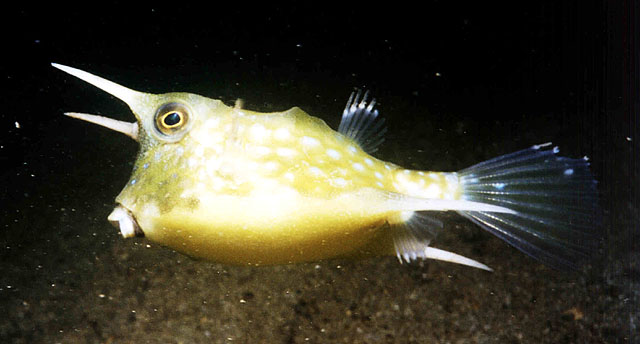| Ostraciidae (Boxfishes) |
| 46 cm TL (male/unsexed) |
|
reef-associated; brackish; marine; depth range 1 - 100 m, non-migratory |
| Indo-Pacific: Red Sea (Ref. 12541) and East Africa (Ref. 12484) to the Marquesan and Tuamoto islands, north to southern Japan, south to Lord Howe Island (Ref. 9710). |
|
Dorsal spines (total): 0-0; Dorsal soft rays (total): 8-9; Anal spines: 0-0; Anal soft rays: 8-9. Cryptic coloring ranges from green and olive to orange with blue spots (Ref. 3141). Caudal fin rays 9-10 (Ref. 1602).
Description: Characterized further by having a pair of sharp "horns" about twice eye diameter in adult, longer in juvenile; "horns" extending anteriorly and slightly upward from front of carapace at level of upper edge of eye; posteriorly directed second pair of spines, one on each side of lower rear edge of carapace; very steep dorsal profile of snout, almost vertical; elongate caudal fin, 1.5-2.0 in SL, truncate margin (often ragged on trailing edge) (Ref. 90102). |
| Inhabit inshore on coastal muddy or sandy habitats in still bays, and commonly found in harbours and estuaries. Small juveniles on protected shallow mudflats (Ref. 48637). Found in weedy areas near rocks or reefs. Juveniles often near river mouths and in brackish water. Adults are solitary, juveniles often form small groups (Ref. 1602). Large adults are shy (Ref. 48637). Feed on benthic invertebrates by blowing away the sand (Ref. 1602). Readily dried and used to make ornaments (Ref. 12484). |
|
Least Concern (LC); Date assessed: 18 August 2023 Ref. (130435)
|
| reports of ciguatera poisoning |
Source and more info: www.fishbase.org. For personal, classroom, and other internal use only. Not for publication.
